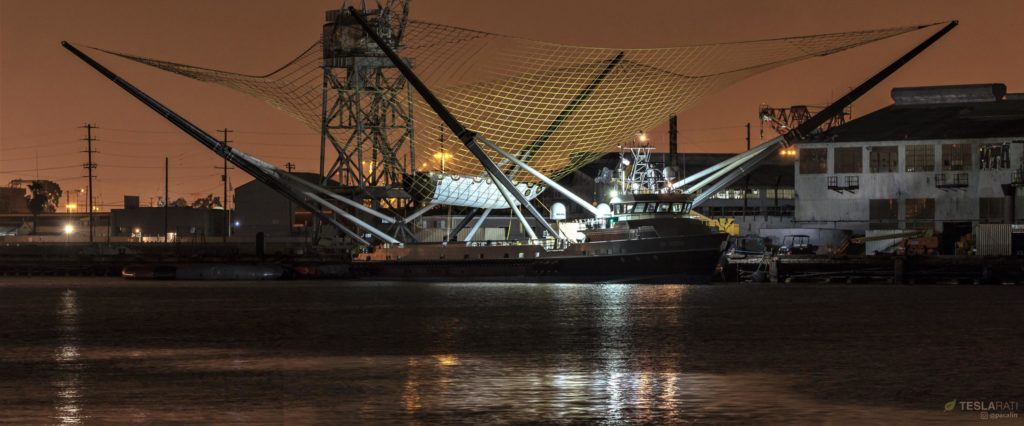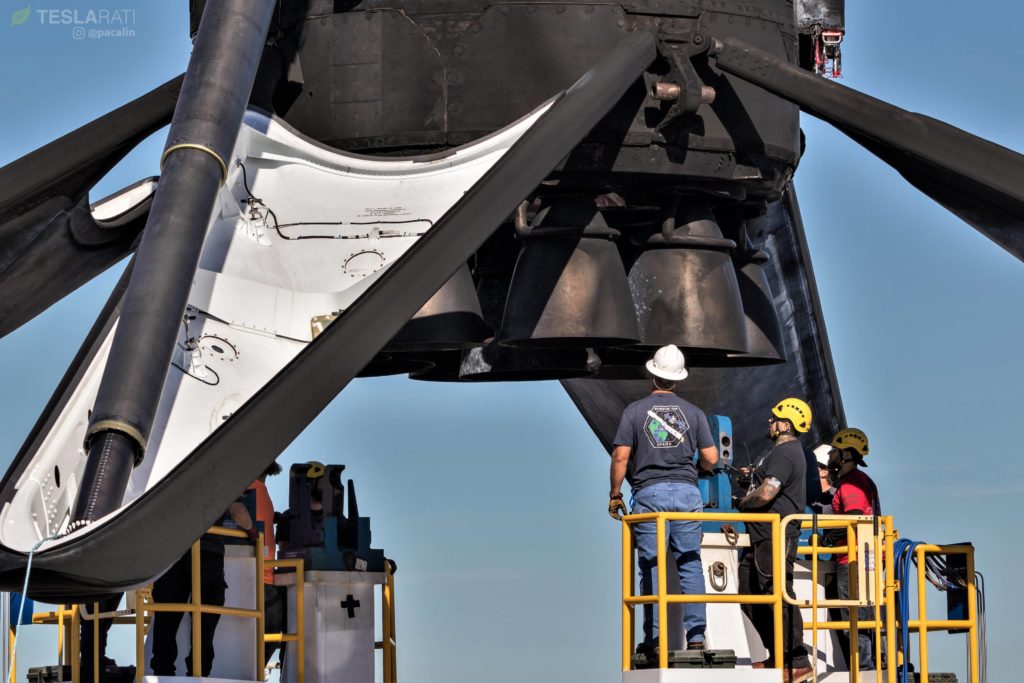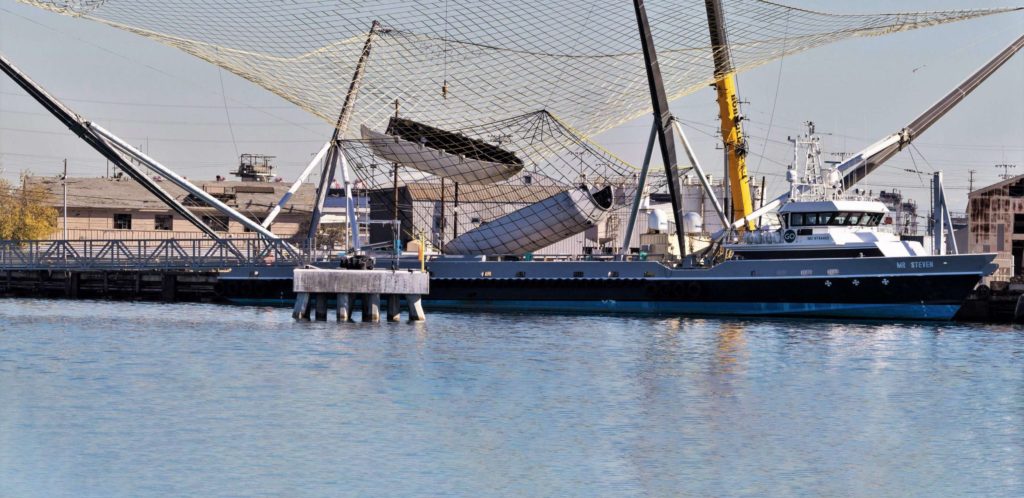SpaceX
SpaceX CEO Elon Musk says Starlink launch will reuse Falcon Heavy’s fairing
SpaceX CEO Elon Musk has revealed that the company successfully recovered both Falcon Heavy Flight 2 fairing halves intact and plans to reuse them this year on an operational Starlink launch.
This will be SpaceX’s first attempt to reuse Falcon payload fairings, a capability that could ultimately save up to 10% – around $6M – and countless production time per launch. Intriguingly, the Falcon Heavy fairing halves were recovered without the use of dedicated recovery vessel Mr. Steven – the vessel has been out of commission for months after an accident ripped off two of its four arms. Instead, the fairing halves parasailed to a soft ocean landing where SpaceX recovery experts aboard GO Searcher and GO Navigator carefully extracted both halves from the surface of the Atlantic. In order to reuse the fairing halves, SpaceX will need to somehow solve – if they haven’t already – the challenge of cleaning contaminated fairings.
How To Clean Your Fairing
The challenge of reusing payload fairings that have been some combination of immersed and thoroughly coated with salt water is by no means an easy one, evidenced primarily by the fact that no company or space agency has yet to try. As a temporary part of a rocket’s uppermost stage, every kilogram of weight present on the fairing can have an almost equally deleterious effect on that same rocket’s ability to place payloads in orbit. This is why the added complexity of additional deployable fairing mechanisms is universally accepted – by jettisoning fairings as soon as possible, rockets are able to carry significantly more payload to a given orbit.
This means that adding even more weight and complexity to fairings – optimized to be extraordinarily light for their often massive sizes – is avoided with extreme prejudice. This is the problem SpaceX faces in its quest to reliably recover and reuse fairings – how does one take fragile objects landing in the middle of the ocean after traveling no less than two kilometers per second (~1.2 mi/s) at apogees upwards of 100 km (62 mi) and prevent them from being destroyed, all while keeping them as light as possible?
SpaceX’s solution was to attach GPS-guided parafoils to each fairing half, as well as cold gas thrusters that allow the halves to orient themselves and remain stable between separation and parafoil deployment. Part two of that solution was to quite literally catch those floating halves out of the air with a giant, speedy boat outfitted with an equally giant net held up by four arms. Despite 5+ catch attempts and many, many controlled drop tests, that vessel – Mr. Steven – has never managed to successfully catch a Falcon fairing half. In early 2019, SpaceX moved the ship from California to Florida due to a launch drought facing the company’s West Coast launch facilities. Less than two weeks after arriving in Florida, an unknown accident resulted in the vessel losing both its net and two of its four arms to the sea, and Mr. Steven has since remained inactive – aside from infrequent trips out and about – in Port Canaveral.

Judging from CEO Elon Musk’s twofold declaration that SpaceX will now reuse its first Falcon fairings without any involvement from Mr. Steven, it’s safe to say that success will sadly bring about the end of the leased fairing recovery vessel’s utility to SpaceX. However, there is a chance that this is not the case.
The fact that SpaceX is choosing to reuse a partially waterlogged fairing for the first time on an internal Starlink internet satellite launch suggests that whatever the solution may be, it may not be compatible – or at least kosher – with current industry standards. All prior reusability milestones have been tested on commercial launches after some sort of private agreement with the customers involved, including the first Falcon 9 booster reuse and the first instances of the same booster being launched for the third time. This is likely not fair to SpaceX or its excellent customers, though. The simpler explanation is that testing unproven technologies and hardware solutions on internal launches fundamentally minimizes the risk conveyed to paying customers that likely can’t afford to lose their spacecraft.


There remains one additional explanation: SpaceX’s solution for reusing waterlogged fairings is, in fact, too immature or is an unacceptable risk of contamination for customers relative to industry standards of design. Instead, SpaceX may have chosen to build some sort of contamination resistance into the clean-slate design of its Starlink satellites, something that would be impractical to expect of customers who have spacecraft that are either already designed or built. Redesigning – let alone rebuilding – complex systems is an extremely costly endeavor. However, wide-reaching changes are far easier to implement when starting from a functionally blank page, exactly where SpaceX is with its first-generation Starlink satellites. As such, SpaceX may have decided to do just this after it realized that catching fairings could be far harder than expected and would thus remain a major bottleneck for Starlink launches if left unsolved.
Finally, it’s unclear if Musk is referring to the very first operational Starlink launch – scheduled as early as May 2019 – or an additional follow-on mission later this year. Refurbishing and reflying fairings for the first time in just one month would be an extremely impressive achievement but may also be an impractical schedule for pathfinder technology development. For now, this serves as a reminder that SpaceX’s first operational Starlink launch is scheduled one month from now.
Check out Teslarati’s Marketplace! We offer Tesla accessories, including for the Tesla Cybertruck and Tesla Model 3.

News
SpaceX shades airline for seeking contract with Amazon’s Starlink rival

SpaceX employees, including its CEO Elon Musk, shaded American Airlines on social media this past weekend due to the company’s reported talks with Amazon’s Starlink rival, Leo.
Starlink has been adopted by several airlines, including United Airlines, Qatar Airways, Hawaiian Airlines, WestJet, Air France, airBaltic, and others. It has gained notoriety as an extremely solid, dependable, and reliable option for airline travel, as traditional options frequently cause users to lose connection to the internet.
Many airlines have made the switch, while others continue to mull the options available to them. American Airlines is one of them.
A report from Bloomberg indicates the airline is thinking of going with a Starlink rival owned by Amazon, called Leo. It was previously referred to as Project Kuiper.
American CEO Robert Isom said (via Bloomberg):
“While there’s Starlink, there are other low-Earth-orbit satellite opportunities that we can look at. We’re making sure that American is going to have what our customers need.”
Isom also said American has been in touch with Amazon about installing Leo on its aircraft, but he would not reveal the status of any discussions with the company.
The report caught the attention of Michael Nicolls, the Vice President of Starlink Engineering at SpaceX, who said:
“Only fly on airlines with good connectivity… and only one source of good connectivity at the moment…”
CEO Elon Musk replied to Nicolls by stating that American Airlines risks losing “a lot of customers if their connectivity solution fails.”
American Airlines will lose a lot of customers if their connectivity solution fails
— Elon Musk (@elonmusk) December 14, 2025
There are over 8,000 Starlink satellites in orbit currently, offering internet coverage in over 150 countries and territories globally. SpaceX expands its array of satellites nearly every week with launches from California and Florida, aiming to offer internet access to everyone across the globe.
Currently, the company is focusing on expanding into new markets, such as Africa and Asia.
News
Tesla hints at Starlink integration with recent patent
“By employing polymer blends, some examples enable RF transmission from all the modules to satellites and other communication devices both inside and outside the vehicle.”

Tesla hinted at a potential Starlink internet terminal integration within its vehicles in a recent patent, which describes a vehicle roof assembly with integrated radio frequency (RF) transparency.
The patent, which is Pub. No U.S. 2025/0368267 describes a new vehicle roof that is made of RF-transparent polymer materials, allowing and “facilitating clear communication with external devices and satellites.”
Tesla believes that a new vehicle roof design, comprised of different materials than the standard metallic or glass elements used in cars today, would allow the company to integrate modern vehicular technologies, “particularly those requiring radio frequency transmission and reception.
Tesla has recently filed a US patent application on integrating RF transparent materials into the roof structure.
“facilitating clear communication with external devices and satellites”
Tesla fleet is getting @Starlink connectivity integration soon. LFG @Tesla @elonmusk… pic.twitter.com/bLa8YtPLd1
— Chansoo Byeon (@Chansoo) December 9, 2025
Instead of glass or metallic materials, Tesla says vehicles may benefit from high-strength polymer blends, such as Polycarbonate, Acrylonitrile Butadiene Styrene, or Acrylonitrile Styrene Acrylate.
These materials still provide ideal strength metrics for crashworthiness, stiffness for noise, vibration, and harshness control, and are compliant with head impact regulations.
They would also enable better performance with modern technologies, like internet terminals, which need an uninterrupted signal to satellites for maximum reception. Tesla writes in the patent:
“By employing polymer blends, some examples enable RF transmission from all the modules to satellites and other communication devices both inside and outside the vehicle.”

One of the challenges Tesla seems to be aware of with this type of roof design is the fact that it will still have to enable safety and keep that at the forefront of the design. As you can see in the illustration above, Tesla plans to use four layers to increase safety and rigidity, while also combating noise and vibration.
It notes in the patent that disclosed examples still meet the safety requirements outlined in the Federal Motor Vehicle Safety Standards (FMVSS).
Starlink integrated directly into Tesla vehicles would be a considerable advantage for owners. It would come with a handful of distinct advantages.
Initially, the inclusion of Starlink would completely eliminate cellular dead zones, something that is an issue, especially in rural areas. Starlink would provide connectivity in these remote regions and would ensure uninterrupted service during road trips and off-grid adventures.
It could also be a critical addition for Robotaxi, as it is crucial to have solid and reliable connectivity for remote monitoring and fleet management.
Starlink’s growing constellation, thanks to SpaceX’s routine and frequent launch schedule, will provide secure, stable, and reliable internet connectivity for Tesla vehicles.
Although many owners have already mounted Starlink Mini dishes under their glass roofs for a similar experience, it may be integrated directly into Teslas in the coming years, either as an upgrade or a standard feature.
Investor's Corner
SpaceX IPO is coming, CEO Elon Musk confirms
However, it appears Musk is ready for SpaceX to go public, as Ars Technica Senior Space Editor Eric Berger wrote an op-ed that indicated he thought SpaceX would go public soon. Musk replied, basically confirming it.

Elon Musk confirmed through a post on X that a SpaceX initial public offering (IPO) is on the way after hinting at it several times earlier this year.
It also comes one day after Bloomberg reported that SpaceX was aiming for a valuation of $1.5 trillion, adding that it wanted to raise $30 billion.
Musk has been transparent for most of the year that he wanted to try to figure out a way to get Tesla shareholders to invest in SpaceX, giving them access to the stock.
He has also recognized the issues of having a public stock, like litigation exposure, quarterly reporting pressures, and other inconveniences.
However, it appears Musk is ready for SpaceX to go public, as Ars Technica Senior Space Editor Eric Berger wrote an op-ed that indicated he thought SpaceX would go public soon.
Musk replied, basically confirming it:
As usual, Eric is accurate
— Elon Musk (@elonmusk) December 10, 2025
Berger believes the IPO would help support the need for $30 billion or more in capital needed to fund AI integration projects, such as space-based data centers and lunar satellite factories. Musk confirmed recently that SpaceX “will be doing” data centers in orbit.
AI appears to be a “key part” of SpaceX getting to Musk, Berger also wrote. When writing about whether or not Optimus is a viable project and product for the company, he says that none of that matters. Musk thinks it is, and that’s all that matters.
It seems like Musk has certainly mulled something this big for a very long time, and the idea of taking SpaceX public is not just likely; it is necessary for the company to get to Mars.
The details of when SpaceX will finally hit that public status are not known. Many of the reports that came out over the past few days indicate it would happen in 2026, so sooner rather than later.
But there are a lot of things on Musk’s plate early next year, especially with Cybercab production, the potential launch of Unsupervised Full Self-Driving, and the Roadster unveiling, all planned for Q1.








